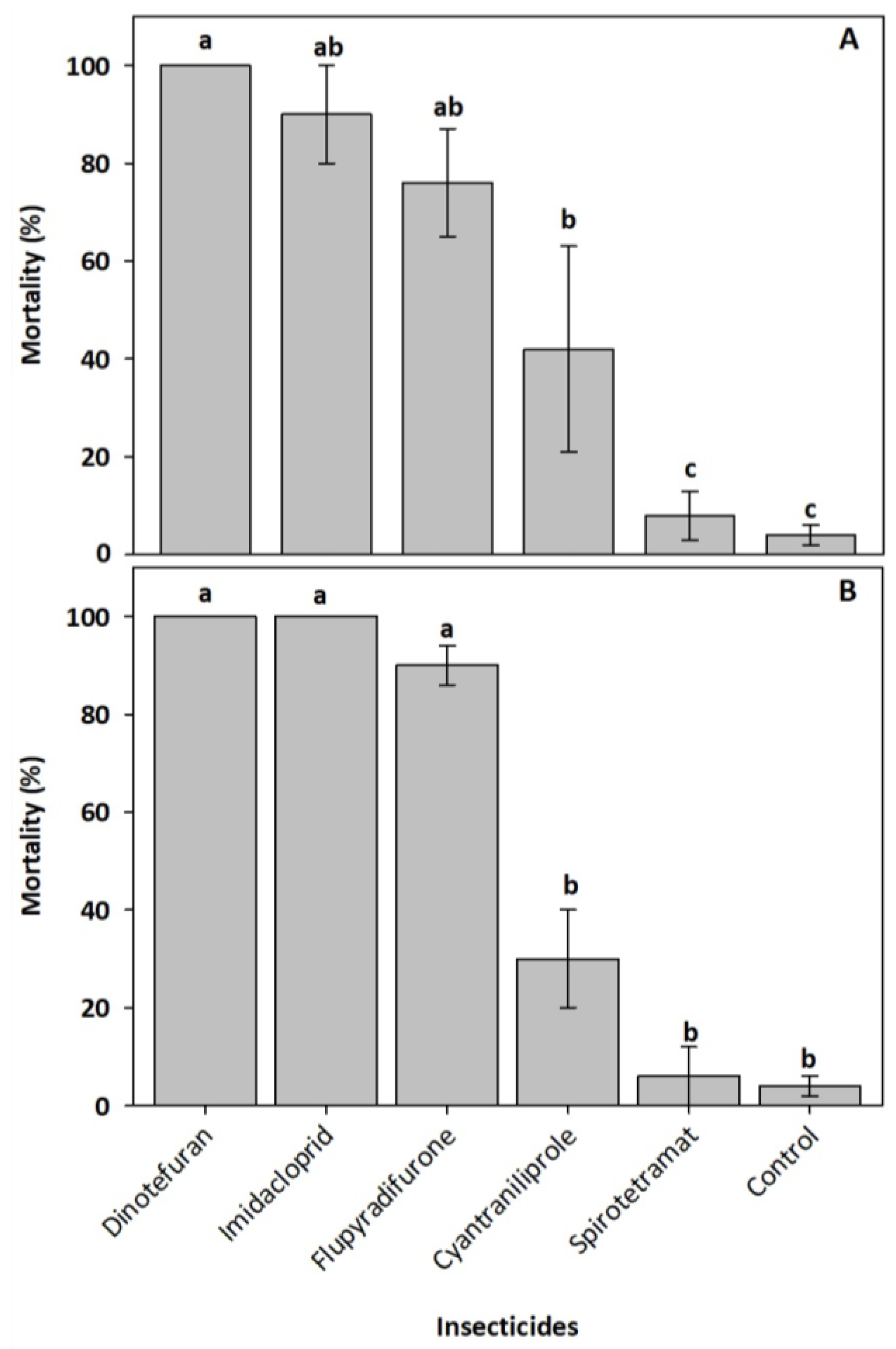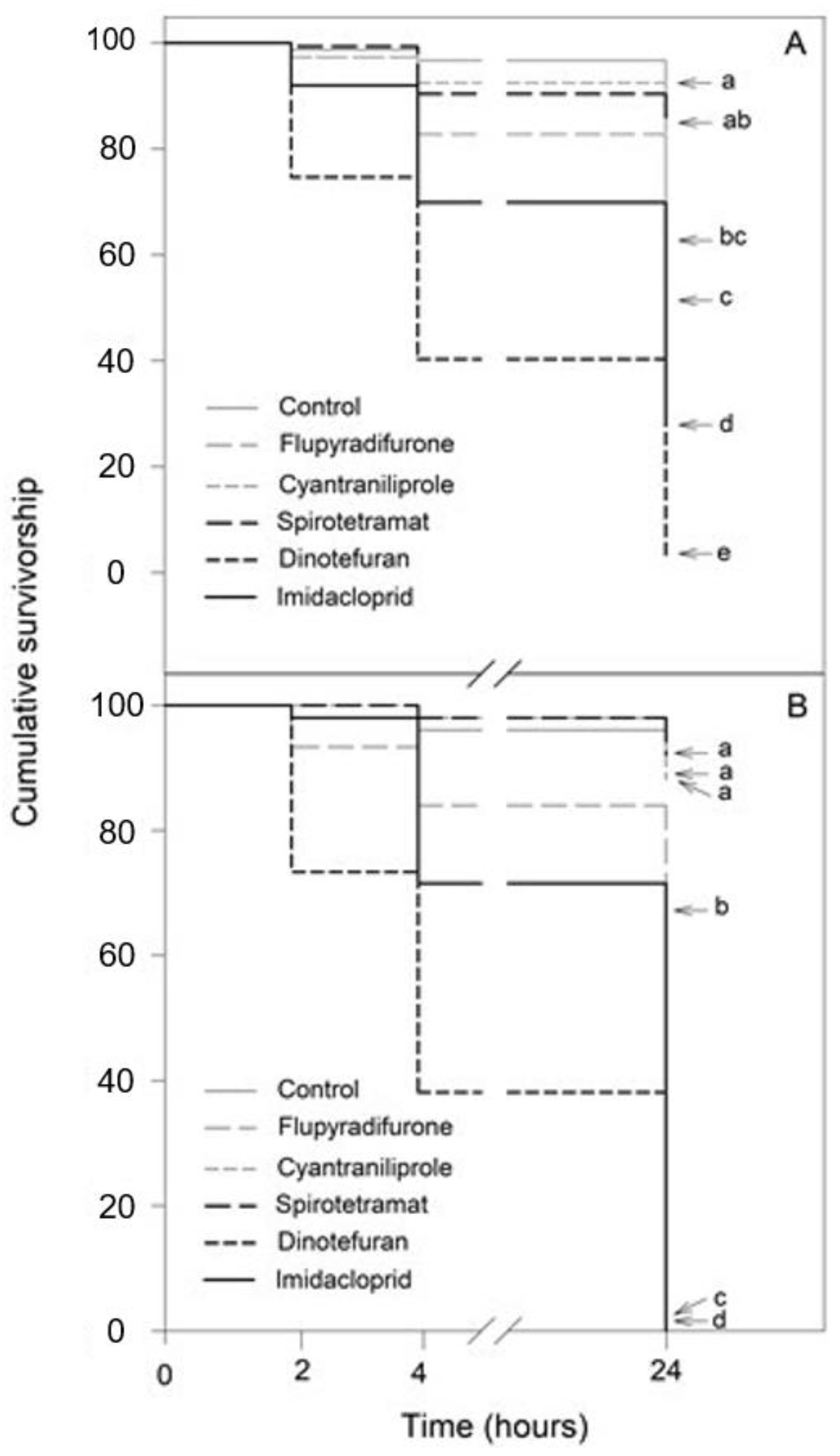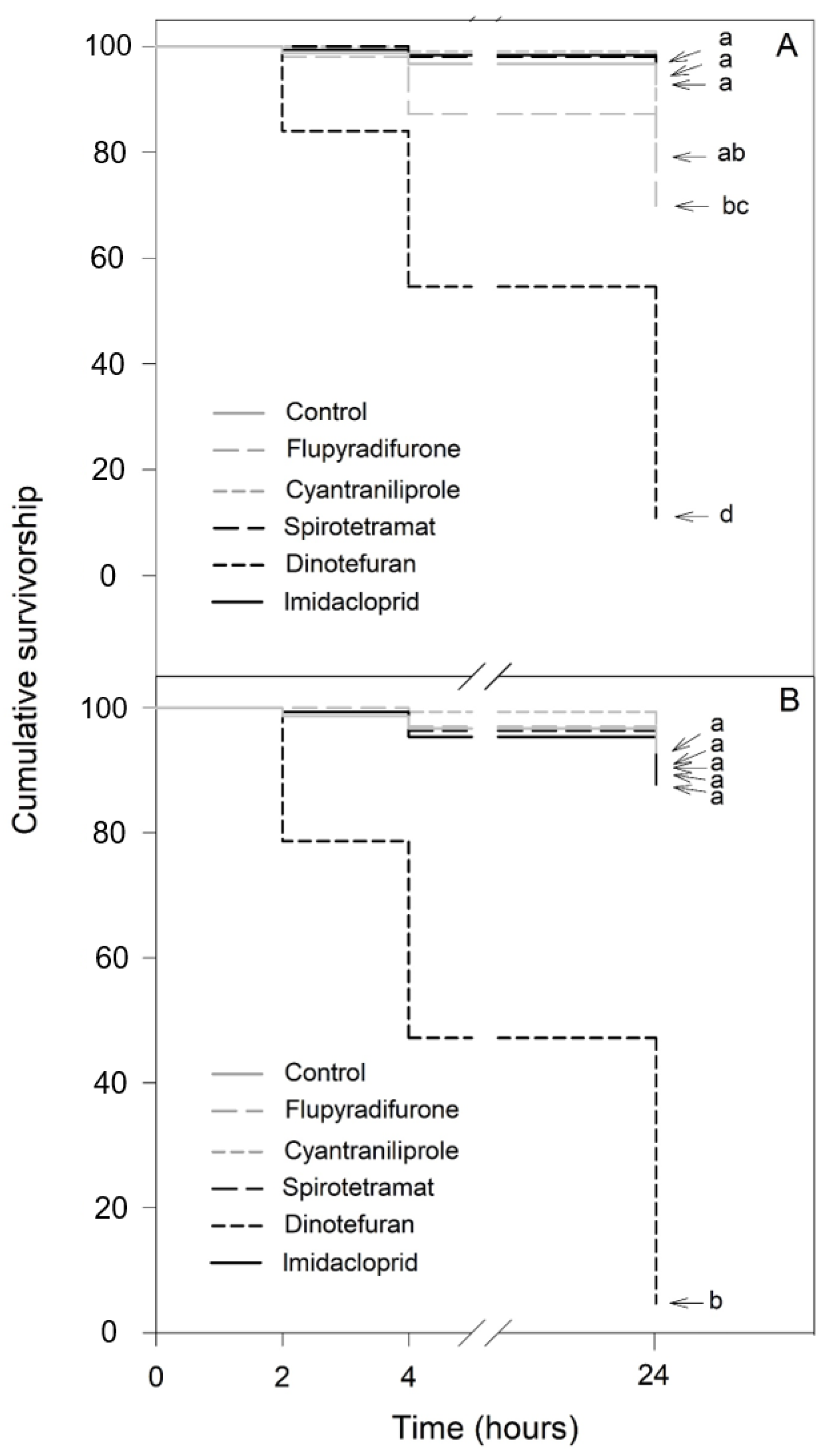Survival Rate of the Neotropical Stingless Bees Nannotrigona perilampoides and Frieseomelitta nigra after Exposure to Five Selected Insecticides, under Controlled Conditions
Abstract
Simple Summary
Abstract
1. Introduction
2. Materials and Methods
2.1. Insects and Insecticides
2.2. Oral Toxicity Bioassay
2.3. Statistical Analysis
3. Results
3.1. Mortality
3.2. Survival Analysis
4. Discussion
5. Conclusions
Supplementary Materials
Author Contributions
Funding
Data Availability Statement
Acknowledgments
Conflicts of Interest
References
- Meléndez-Ramírez, V.; Ayala, R.; Delfín-González, H. Crop pollination by stingless bees. In Pot-Pollen in Stingless Bee Melittology, 1st ed.; Vit, P., Pedro, S.R.M., Roubik, D.W., Eds.; Springer Cham: Cham, Switzerland, 2018; pp. 139–153. [Google Scholar] [CrossRef]
- Cauich, O.; Quezada-Euán, J.J.G.; Macias-Macias, J.O.; Reyes-Oregel, V.; Medina-Peralta, S.; Parra-Tabla, V. Behavior and pollination efficiency of Nannotrigona perilampoides (Hymenoptera: Meliponini) on greenhouse tomatoes (Lycopersicon esculentum) in subtropical Mexico. J. Econ. Entomol. 2004, 97, 475–481. [Google Scholar] [CrossRef] [PubMed]
- Can-Alonzo, C.; Quezada-Euán, J.J.G.; Ancona-Xiu, P.; Moo-Valle, H.; Valdovinos-Nuñez, G.R.; Medina-Peralta, S. Pollination of ‘criollo’ avocados (Persea americana) and the behaviour of associated bees in subtropical Mexico. J. Apic. Res. 2005, 44, 3–8. [Google Scholar] [CrossRef]
- Cauich, O.; Quezada-Euán, J.J.G.; Meléndez-Ramírez, V.; Valdovinos-Nuñez, G.R.; Moo-Valle, H. Pollination of habanero pepper (Capsicum chinense) and production in enclosures using the stingless bee Nannotrigona perilampoides. J. Apic. Res. 2006, 45, 125–130. [Google Scholar] [CrossRef]
- Romero, M.J.; Quezada-Euán, J.J.G. Pollinators in biofuel agricultural systems: The diversity and performance of bees (Hymenoptera: Apoidea) on Jatropha curcas in Mexico. Apidologie 2013, 44, 419–429. [Google Scholar] [CrossRef]
- Caro, A.; Moo-Valle, H.; Alfaro, R.; Quezada-Euán, J.J.G. Pollination services of Africanized honey bees and native Melipona beecheii to buzz-pollinated annatto (Bixa orellana L.) in the neotropics. Agric. For. Entomol. 2016, 19, 274–280. [Google Scholar] [CrossRef]
- Landaverde-González, P.; Quezada-Euán, J.J.G.; Theodorou, P.; Murray, T.E.; Husemann, M.; Ayala, R.; Moo-Valle, H.; Vandame, R.; Paxton, J.R. Sweat bees on hot chillies: Provision of pollination services by native bees in traditional slash-and-burn agriculture in the Yucatán Peninsula of tropical Mexico. J. Appl. Ecol. 2017, 54, 1814–1824. [Google Scholar] [CrossRef]
- Cairns, C.E.; Villanueva-Gutiérrez, R.; Koptur, S.; Bray, B.D. Bee populations, forest disturbance, and africanization in Mexico. Biotropica 2005, 37, 686–692. [Google Scholar] [CrossRef]
- Brosi, B.J. The complex responses of social stingless bees (Apidae: Meliponini) to tropical deforestation. For. Ecol. Manag. 2009, 258, 830–1837. [Google Scholar] [CrossRef]
- Mayes, D.M.; Bhatta, C.P.; Shi, D.; Brown, J.C.; Smith, D.R. Body size influences stingless bee (Hymenoptera: Apidae) communities across a range of deforestation levels in Rondônia, Brazil. J. Insect Sci. 2019, 19, 23. [Google Scholar] [CrossRef]
- Main, A.R.; Webb, E.B.; Goyne, K.W.; Mengel, D. Reduced species richness of native bees in field margins associated with neonicotinoid concentrations in non-target soils. Agric. Ecosyst. Environ. 2020, 287, 106693. [Google Scholar] [CrossRef]
- Macias-Macias, O.; Chuc, P.; Ancona-Xiu, P.; Cauich, O.; Quezada-Euán, J.J.G. Contribution of native bees and Africanized honeybees (Hymenoptera: Apoidea) to Solanaceae crop pollination in tropical México. J. Appl. Entomol. 2009, 133, 456–465. [Google Scholar] [CrossRef]
- Montejo-Canul, E.; Aguiñaga-Bravo, A.; Ruiz-Sánchez, E.; Ballina-Gómez, H.; González-Moreno, A.; Latournerie-Moreno, L.; Martín-Mex, R.; Garruña-Hernández, R. Effects of the inclusion of biorational insecticides for pest management on phytophagous insects, fruit yield, and bee abundance in tomato and tomatillo. Arch. Phytopathol. Pflanzenschutz 2019, 52, 17–18. [Google Scholar] [CrossRef]
- Chen, J.-C.; Wang, Z.-H.; Cao, L.-J.; Gong, Y.-J.; Hoffmann, A.A.; Wei, S.-J. Toxicity of seven insecticides to different developmental stages of the whitefly Bemisia tabaci MED (Hemiptera: Aleyrodidae) in multiple field populations of China. Ecotoxicology 2018, 27, 742–751. [Google Scholar] [CrossRef] [PubMed]
- Monroy-Reyes, B.; Carrillo-Gutiérrez, T.; Beas-Zarate, C.; Posos-Ponce, P.; Castro-Rodriguez, M.; Enciso-Cabral, J.G.; Flores-Galano, G. Evaluación de efectividad biológica del insecticida Benevia 10 OD (ciantraniliprol) para el control de Frankliniella occidentalis pergande, (Thysanoptera: Thripidae) en aguacate. Entomología Mexicana 2019, 6, 188–193. [Google Scholar]
- Siviter, H.; Muth, F. Do novel insecticides pose a threat to beneficial insects? Proc. R. Soc. B 2020, 287, 20201265. [Google Scholar] [CrossRef]
- Botina, L.L.; Bernardes, R.C.; Barbosa, W.F.; Lima, M.A.P.; Guedes, R.N.C.; Martins, G.F. Toxicological assessments of agrochemical effects on stingless bees (Apidae, Meliponini). MethodsX 2020, 7, 100906. [Google Scholar] [CrossRef]
- Lourenço, C.T.; Carvalho, S.M.; Malaspina, O.; Nocelli, R.C.F. Oral toxicity of fipronil insecticide against the stingless bee Melipona scutellaris (Latreille, 1811). Bull. Environ. Contam. Toxicol. 2012, 89, 921–924. [Google Scholar] [CrossRef]
- Jacob, C.R.O.; Malaquias, J.B.; Zanardi, O.Z.; Silva, C.A.S.; Jacob, J.F.O.; Yamamoto, P.T. Oral acute toxicity and impact of neonicotinoids on Apis mellifera L. and Scaptotrigona postica Latreille (Hymenoptera: Apidae). Ecotoxicology 2019, 28, 744–753. [Google Scholar] [CrossRef]
- Sanchez-Bayo, F.; Goka, K. Pesticide residues and bees–a risk assessment. PLoS ONE 2014, 9, e94482. [Google Scholar] [CrossRef]
- Lima, M.A.P.; Martins, G.F.; Oliveira, E.E.; Guedes, R.N.C. Agrochemical-induced stress in stingless bees: Peculiarities, underlying basis, and challenges. J. Comp. Physiol. A 2016, 202, 733–747. [Google Scholar] [CrossRef]
- Cham, K.O.; Nocelli, R.C.F.; Borges, L.O.; Viana-Silva, F.E.C.; Tonelli, C.A.M.; Menezes, O.M.C.; Rosa-Fontana, A.S.; Blochtein, B.; Freitas, B.M.; Pires, C.S.S.; et al. Pesticide exposure assessment paradigm for stingless bees. Environ. Entomol. 2018, 20, 36–48. [Google Scholar] [CrossRef] [PubMed]
- Cresswell, J.E. A meta-analysis of experiments testing the effects of a neonicotinoid insecticide (imidacloprid) on honey bees. Ecotoxicology 2011, 20, 149–157. [Google Scholar] [CrossRef] [PubMed]
- Goulson, D. An overview of the environmental risks posed by neonicotinoid insecticides. J. Appl. Ecol. 2013, 50, 977–998. [Google Scholar] [CrossRef]
- Arena, M.; Sgolastra, F. A meta-analysis comparing the sensitivity of bees to pesticides. Ecotoxicology 2014, 23, 324–334. [Google Scholar] [CrossRef]
- Tosi, S.; Nieh, J.C. Lethal and sublethal synergistic effects of a new systemic pesticide, flupyradifurone (Sivanto®), on honeybees. Proc. R. Soc B 2019, 286, 20190433. [Google Scholar] [CrossRef] [PubMed]
- Nauen, R.; Jeschke, P.; Velten, R.; Beck, M.E.; Ebbinghaus-Kintscher, U.; Thielert, W.; Wölfel, K.; Hass, M.; Kunz, K.; Raupach, G. Flupyradifurone: A brief profile of a new butenolide insecticide. Pest Manag. Sci. 2015, 71, 850–862. [Google Scholar] [CrossRef] [PubMed]
- Hesselbach, H.; Scheiner, R. Effects of the novel pesticide flupyradifurone (Sivanto) on honeybee taste and cognition. Sci. Rep. 2018, 8, 4954. [Google Scholar] [CrossRef] [PubMed]
- Tomé, H.V.V.; Barbosa, W.F.; Corrêa, A.S.; Gontijo, L.M.; Martins, G.F.; Guedes, R.N.C. Reduced-risk insecticides in neotropical stingless bee species: Impact on survival and activity. Ann. Appl. Biol. 2015, 167, 186–196. [Google Scholar] [CrossRef]
- Kadala, A.; Charreton, M.; Charnet, P.; Collet, C. Honey bees long-lasting locomotor deficits after exposure to the diamide chlorantraniliprole are accompanied by brain and muscular calcium channels alterations. Sci. Rep. 2019, 9, 2153. [Google Scholar] [CrossRef]
- Zhang, Z.; Xu, C.; Ding, J.; Zhao, Y.; Lin, J.; Liu, F.; Mu, W. Cyantraniliprole seed treatment efficiency against Agrotis ipsilon (Lepidoptera: Noctuidae) and residue concentrations in corn plants and soil. Pest Manag. Sci. 2019, 75, 1464–1472. [Google Scholar] [CrossRef]
- Li, Y.; Dou, Y.; An, J.; Tu, X.; Lv, H.; Pan, W.; Dang, Z.; Gao, Z. Temperature-dependent variations in toxicity of diamide insecticides against three lepidopteran insects. Ecotoxicology 2020, 29, 607–612. [Google Scholar] [CrossRef] [PubMed]
- Renkema, J.M.; Krey, K.; Devkota, S.; Liburd, O.E.; Funderburk, J. Efficacy of insecticides for season-long control of thrips (Thysanoptera: Thripidae) in winter strawberries in Florida. Crop Prot. 2020, 127, 104945. [Google Scholar] [CrossRef]
- Selby, T.P.; Lahm, G.P.; Stevenson, T.M.; Hughes, K.A.; Cordova, D.; Annan, I.B.; Barry, J.D.; Benner, E.A.; Currie, M.J.; Pahutski, T.F. Discovery of cyantraniliprole, a potent and selective anthranilic diamide ryanodine receptor activator with cross-spectrum insecticidal activity. Bioorg. Med. Chem. Lett. 2013, 23, 6341–6345. [Google Scholar] [CrossRef] [PubMed]
- Isaacs, A.K.; Qi, S.; Sarpong, R.; Casida, J.E. Insect ryanodine receptor: Distinct but coupled insecticide binding sites for N-C(3)H(3) chlorantraniliprole, flubendiamide, and (3)H ryanodine. Chem. Res. Toxicol. 2012, 25, 1571–1573. [Google Scholar] [CrossRef] [PubMed]
- Dinter, A.; Samel, A. Cyantraniliprole: Pollinator profile of the novel insecticides under laboratory, semi-field and field conditions. In Proceedings of the Hazards of Pesticides to Bees–12th International Symposium of the ICP-Bee Protection Group, Ghent, Belgium, 15–17 September 2014. [Google Scholar]
- Qi, S.; Casida, J.E. Species differences in chlorantraniliprole and flubendiamide insecticide binding sites in the ryanodine receptor. Pestic. Biochem. Phys. 2013, 107, 321–326. [Google Scholar] [CrossRef]
- Lümmen, P.; Khajehali, J.; Luther, K.; Van Leeuwen, T. The cyclic keto-enol insecticide spirotetramat inhibits insect and spider mite acetyl-CoA carboxylases by interfering with the carboxyltransferase partial reaction. Insect Biochem. Mol. Biol. 2014, 55, 1–8. [Google Scholar] [CrossRef]
- Popov, S.Y.; Alyokhin, A. Gender-Specific acaricidal properties and sexual transmission of spirotetramat in two-spotted spider mite (Tetranychidae: Acariformes). J. Econ. Entomol. 2019, 112, 2186–2192. [Google Scholar] [CrossRef]
- Nauen, R.; Reckmann, U.; Thomzik, J.; Thielert, W. Biological profile of spirotetramat (Movento®)–a new two-way systemic (ambimobile) insecticide against sucking pest species. Bayer Cropsci. J. 2008, 61, 245–278. [Google Scholar]
- Brück, E.; Elbert, A.; Fischer, R.; Krueger, S.; Kühnhold, J.; Klueken, A.M.; Nauen, R.; Niebes, J.F.; Reckmann, U.; Schnorbach, H.J.; et al. Movento®, an innovative ambimobile insecticide for sucking insect pest control in agriculture: Biological profile and field performance. Crop Prot. 2009, 28, 838–844. [Google Scholar] [CrossRef]
- Marčić, D.; Perić, P.; Petronijević, S.; Prijović, M.; Drobnjaković, T. Cyclic ketoenols: Acaricides and insecticides with a novel mode of action. Pestic. I Fitomed. 2011, 26, 185–195. [Google Scholar] [CrossRef]
- Maus, C. Ecotoxicological profile of the insecticide spirotetramat. Bayer Cropsci. J. 2008, 61, 159–180. [Google Scholar]
- Vinothkumar, B.; Kumaran, N.; Boomathi, N.; Saravanan, P.A.; Kuttalam, S. Toxicity of spirotetramat 150 OD to honeybees. Madras Agric. J. 2010, 97, 86–87. [Google Scholar]



| Insecticide (Chemical Group) | Concentration (Formulation) a | Evaluated Concentrations (mg L−1) * | Trade Name (Manufacturer) | Mode of Action |
|---|---|---|---|---|
| Dinotefuran (Neonicotinoid) | 200 g/kg (SG) | 600, 60, 6 | Venom 20 SG (Valent) | Agonist of Nicotinic Acetylcholine receptor (nAChR) |
| Imidacloprid (Neonicotinoid) | 350 g a.i. L−1 (SC) | 700, 70, 7 | Confial (Quimica Sagal) | Agonist of Nicotinic Acetylcholine receptor (nAChR) |
| Flupyradifurone (Butenolide) | 200 g a.i. L−1 (SL) | 680, 68, 6.8 | Sivanto Prime (Bayer Crop Science) | Agonist of Nicotinic Acetylcholine receptor (nAChR) |
| Spirotetramat (Cyclic keto-enol) | 150 g a.i. L−1 (OD) | 300, 30, 3 | Movento 150 OD (Bayer Crop Science) | Inhibitor of acetyl CoA carboxilase |
| Cyantraniliprole (Anthranilic diamide) | 200 g L−1 (SC) | 200, 20, 2 | Benevia (FMC) | Activator of Ryanodine Receptor (RyR) |
Publisher’s Note: MDPI stays neutral with regard to jurisdictional claims in published maps and institutional affiliations. |
© 2022 by the authors. Licensee MDPI, Basel, Switzerland. This article is an open access article distributed under the terms and conditions of the Creative Commons Attribution (CC BY) license (https://creativecommons.org/licenses/by/4.0/).
Share and Cite
Góngora-Gamboa, C.; Ruiz-Sánchez, E.; Ballina-Gómez, H.S.; González-Moreno, A.; Zamora-Bustillos, R. Survival Rate of the Neotropical Stingless Bees Nannotrigona perilampoides and Frieseomelitta nigra after Exposure to Five Selected Insecticides, under Controlled Conditions. Insects 2022, 13, 961. https://doi.org/10.3390/insects13100961
Góngora-Gamboa C, Ruiz-Sánchez E, Ballina-Gómez HS, González-Moreno A, Zamora-Bustillos R. Survival Rate of the Neotropical Stingless Bees Nannotrigona perilampoides and Frieseomelitta nigra after Exposure to Five Selected Insecticides, under Controlled Conditions. Insects. 2022; 13(10):961. https://doi.org/10.3390/insects13100961
Chicago/Turabian StyleGóngora-Gamboa, Cristian, Esaú Ruiz-Sánchez, Horacio S. Ballina-Gómez, Alejandra González-Moreno, and Roberto Zamora-Bustillos. 2022. "Survival Rate of the Neotropical Stingless Bees Nannotrigona perilampoides and Frieseomelitta nigra after Exposure to Five Selected Insecticides, under Controlled Conditions" Insects 13, no. 10: 961. https://doi.org/10.3390/insects13100961
APA StyleGóngora-Gamboa, C., Ruiz-Sánchez, E., Ballina-Gómez, H. S., González-Moreno, A., & Zamora-Bustillos, R. (2022). Survival Rate of the Neotropical Stingless Bees Nannotrigona perilampoides and Frieseomelitta nigra after Exposure to Five Selected Insecticides, under Controlled Conditions. Insects, 13(10), 961. https://doi.org/10.3390/insects13100961






